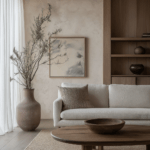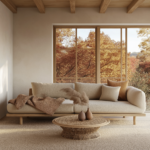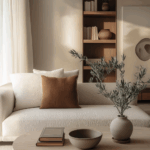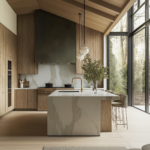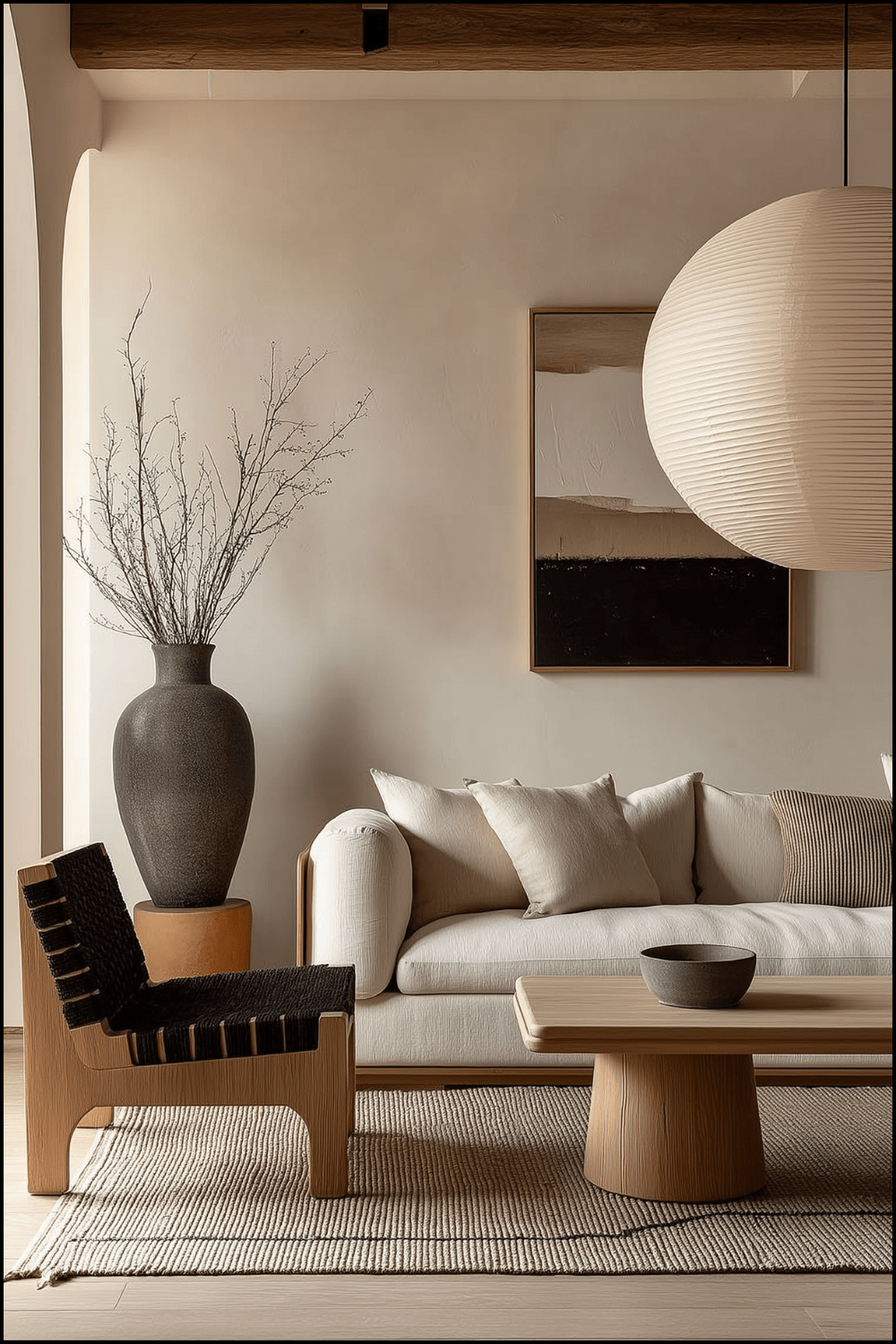
In a world that feels louder and faster by the day, Japandi interior design offers a quiet escape; a serene fusion of Japanese wabi-sabi and Scandinavian simplicity that feels like a deep exhale. It’s more than a design trend; it’s a lifestyle rooted in mindfulness, beauty, and intention. With its clean lines, warm textures, and nature-inspired palette, Japandi invites us to create spaces that are not just clutter-free but soulfully composed.
What makes this aesthetic so timeless is its ability to blend form and feeling; the purposeful elegance of Scandinavian design with the grounded imperfection of wabi-sabi living. In a Japandi space, everything has a reason to be there… and just as importantly, there’s room for what truly matters: peace, clarity, and connection. If you’ve ever longed for a home that feels both minimal and meaningful, cozy yet uncluttered, you’re in the right place. Let’s explore the essence of Japandi and how to bring this harmonious design style into your everyday life. 🕊️
What Is Japandi Interior Design?
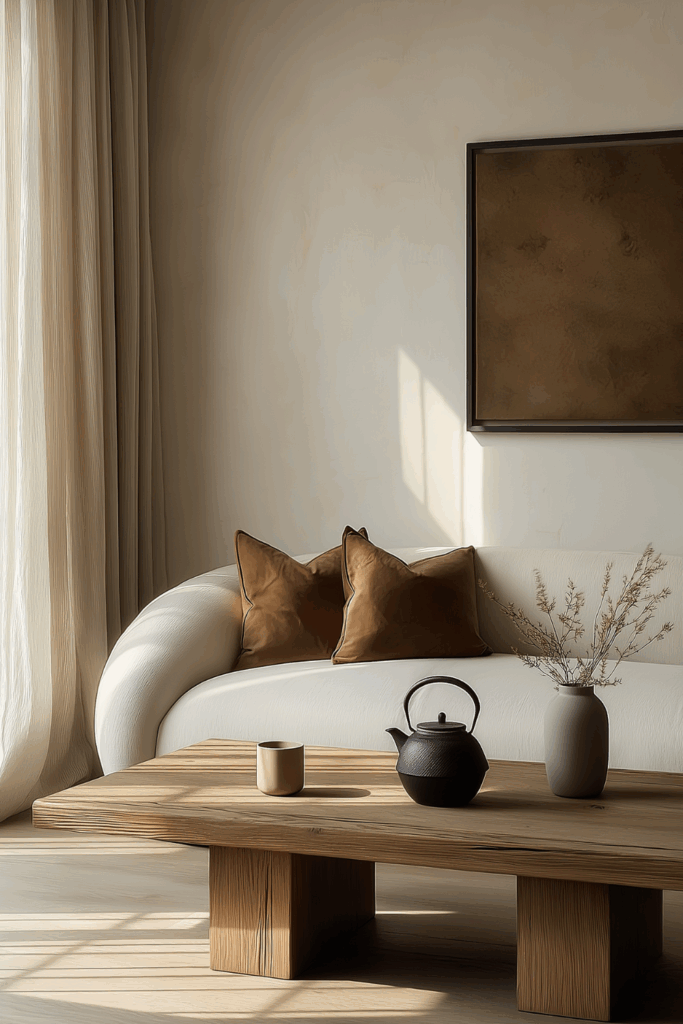
At its core, Japandi interior design is a love story between two timeless aesthetics: the quiet beauty of Japanese wabi-sabi and the functional elegance of Scandinavian minimalism. The term Japandi blends “Japanese” and “Scandi,” and the result is more than just a design trend; it’s a way of living with purpose, mindfulness, and grace.
From Japan, we inherit the philosophy of wabi-sabi, which celebrates imperfection, transience, and simplicity. It teaches us to find beauty in the unrefined: a hand-thrown clay vessel, a weathered wood stool, a muted palette inspired by nature’s rhythms. From Scandinavia, we welcome the principles of hygge and functional design, characterized by cozy textures, airy, light-filled spaces, and furniture crafted with care and intention.
Together, these influences form a style that’s rooted in harmony, balance, and restraint, where every element serves a purpose, and nothing feels excessive. Japandi rooms are often grounded in natural materials like oak, linen, and stone, and feature thoughtful craftsmanship over fleeting trends. Each space is designed to feel calm, clean, and quietly luxurious, with a deep reverence for both form and function.
In a world that often feels chaotic and cluttered, Japandi offers a breath of fresh air; an invitation to live more slowly, more intentionally, and more soulfully.
Core Principles of Japandi Aesthetic
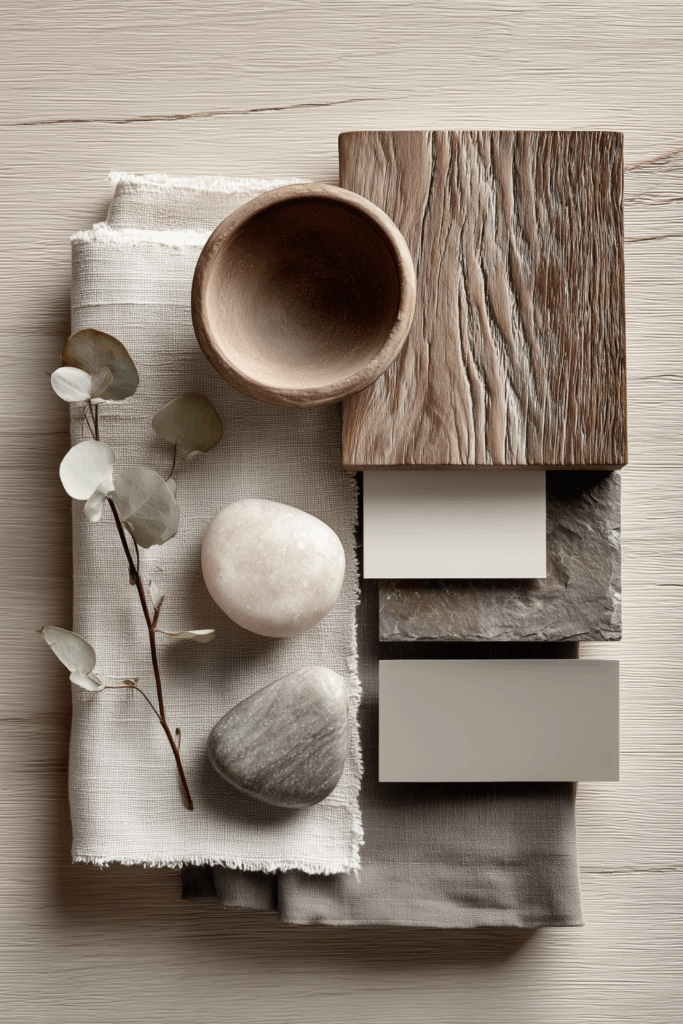
At the heart of Japandi interior design is a quiet kind of beauty; one that doesn’t clamor for attention, but instead invites you to slow down and breathe deeply. This is where warm minimalism meets soulful intention.
Warm Minimalism:
Japandi isn’t just about having less, it’s about choosing better. Each item in the space is considered and meaningful; nothing is excessive, yet nothing feels sterile. Think cozy textures, soft lighting, and negative space that feels restful rather than bare.
Wabi-Sabi Beauty:
Drawing from the Japanese philosophy of wabi-sabi, Japandi interiors embrace the imperfect and the impermanent. A weathered wooden stool, a hand-thrown ceramic cup, a linen pillow with a slightly rumpled edge; these are the touches that bring authenticity and soul to a minimalist space.
Scandinavian Functionality:
Rooted in Scandinavian design, Japandi style prizes function just as much as form. Every piece should serve a purpose, but do so beautifully. You’ll often find streamlined furniture with clean lines, designed for comfort and practicality without sacrificing style.
Connection to Nature:
Japandi spaces are a sanctuary of natural textures. You’ll see light and dark woods, soft linen textiles, raw stone surfaces, and delicate handmade pottery all working together to create a grounding, tactile environment that echoes the serenity of the outdoors.
Muted, Earthy Palettes:
Color is never loud in a Japandi home. Instead, hues are soft and subdued: warm whites, taupe, stone gray, charcoal, and touches of muted green. These tones create a calming backdrop that allows texture and light to take center stage. Together, these principles offer a space that’s both elevated and inviting. It’s the kind of design that doesn’t just look good… it feels good.
Room-by-Room Japandi Inspiration
One of the most magical things about Japandi interior design is how effortlessly it adapts to every space in the home, offering calm, cohesion, and quiet sophistication. Let’s take a room-by-room look at how this aesthetic can shape your space into a sanctuary.
The Living Room: Grounded and Intentional
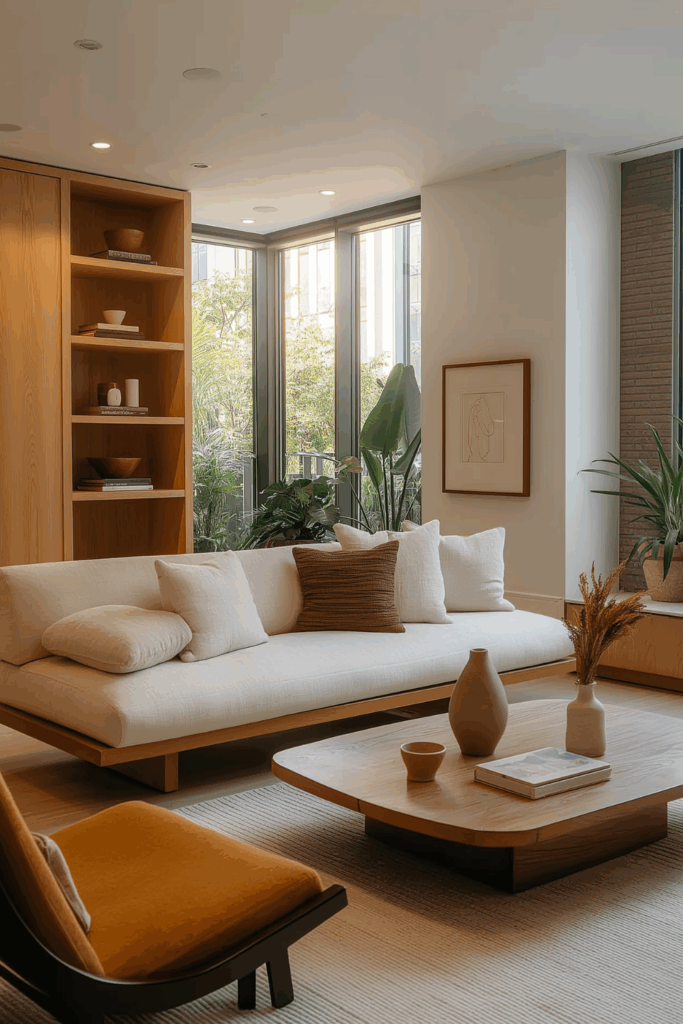
In a Japandi living room, every piece serves a purpose, and every choice is made with care. Low-profile seating like a neutral linen sofa or a wood-framed accent chair encourages relaxation while maintaining a sleek silhouette. Layered textiles add cozy depth: think soft throws, textured pillows, and a plush, natural fiber rug underfoot.
Warm wood tones and sculptural decor soften the minimalism, while the styling remains curated, not crowded. A single ceramic vase with a dried branch or a hand-carved bowl on the coffee table adds beauty without overwhelming the senses.
The Bedroom: Earthy, Soft, and Serene
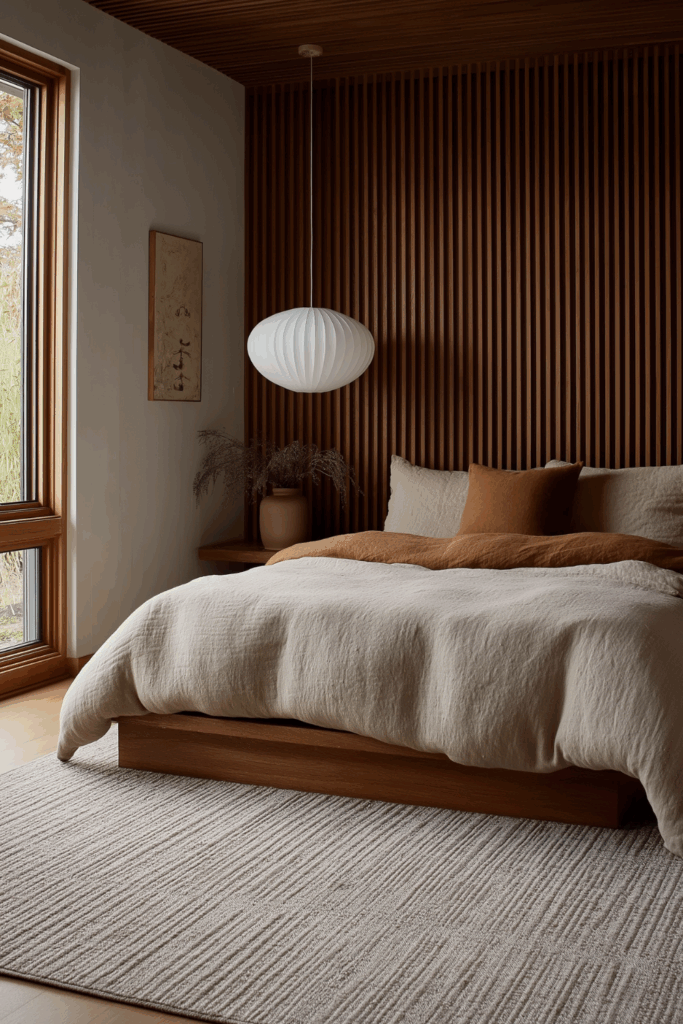
Step into a Japandi bedroom and you’ll immediately feel the shift; this is a space designed to cocoon and calm. A low platform bed dressed in flax linen invites rest, while warm wood nightstands and a slatted feature wall add subtle rhythm and organic charm.
Color is gentle here: earthy clay, warm ivory, soft sage. A single paper lantern pendant casts a diffused, restful glow. With minimal decor and natural materials, the result is a sleep space that feels both grounded and weightless.
The Kitchen & Dining Area: Simple Pleasures, Thoughtfully Styled
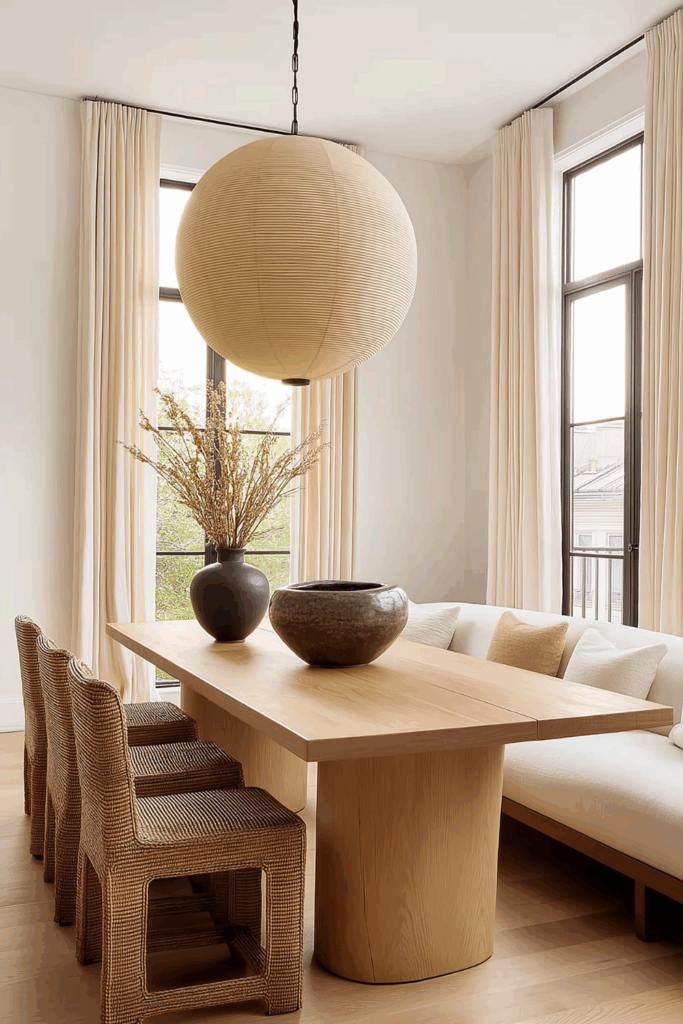
In the Japandi kitchen and dining space, functionality is art. Open shelving displays only the essentials: beautifully imperfect handmade ceramics, wooden cutting boards, and glass jars with pantry staples.
A simple oak dining table anchors the room, surrounded by woven or spindle-back chairs that celebrate craftsmanship. Light flows freely through uncluttered windows, while a ceramic bowl or minimalist floral arrangement brings organic life to the center of the table. The atmosphere? Warm, welcoming, and wonderfully unpretentious.
The Entryway: A Quiet Invitation
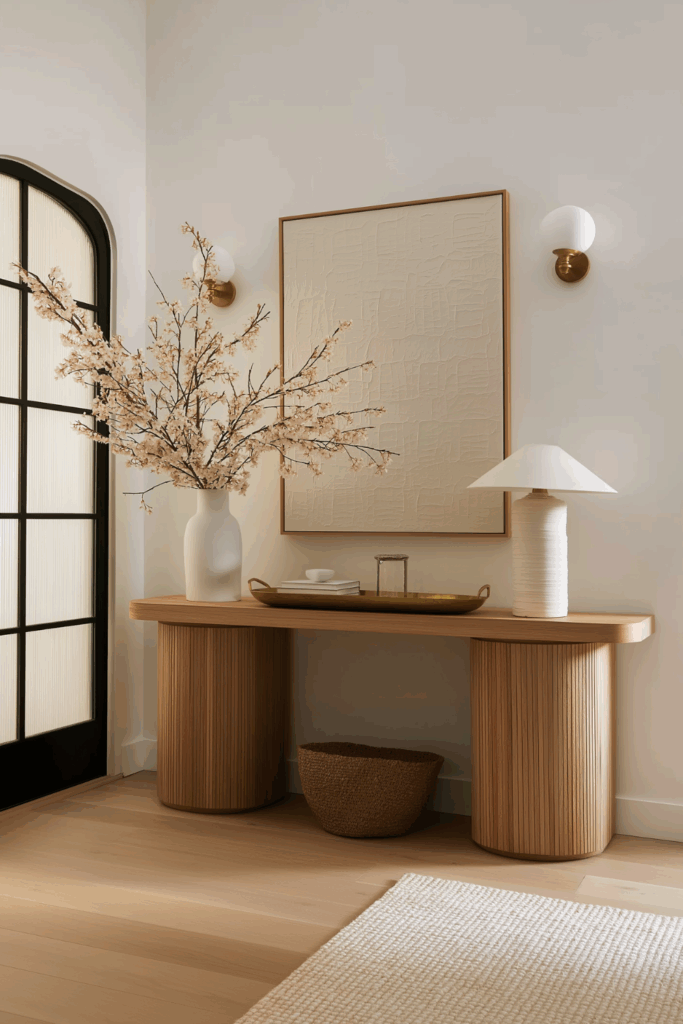
Even the smallest spaces benefit from Japandi’s thoughtful touch. In the entryway, a simple wood bench offers both seating and a sense of arrival. Stone or clay trays keep everyday essentials organized, while a mirror or softly curved decor piece reflects light and adds visual ease.
Here, form meets function in its purest expression; each detail is intentional, and nothing is extra. It’s an invitation to slow down the moment you step inside.
Tips to Bring Japandi Into Your Home
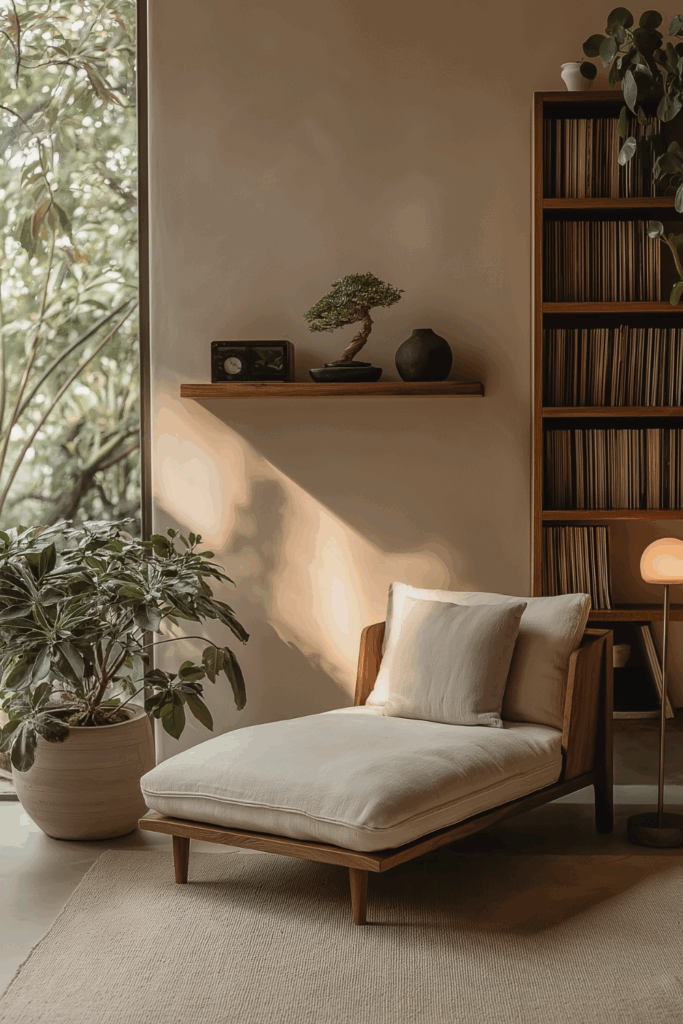
If the Japandi aesthetic is calling to you, you’re not alone. This soulful blend of Scandinavian simplicity and Japanese serenity offers a timeless antidote to the chaos of modern life. The good news? You don’t need a full renovation to invite this style into your home. Here are a few thoughtful ways to begin weaving Japandi into your space, one intentional choice at a time.
1. Start with a Neutral, Earthy Palette
At the heart of Japandi interiors is a quiet, grounding color story. Begin by choosing a palette inspired by nature: think warm whites, stone greys, sandy taupes, muted sage, and soft charcoal. These colors act like a breath of fresh air for your home, creating an atmosphere that feels calm, clean, and cohesive from room to room.
2. Choose Quality Over Quantity
Japandi is all about thoughtful minimalism. That doesn’t mean your home should feel empty; it means everything in your space should feel essential, beautiful, and built to last. Invest in pieces made from natural materials like oak, walnut, linen, ceramic, and stone. Let the grain, texture, and craftsmanship take center stage. A handmade stool or a sculptural floor lamp can do more for a room than a dozen trend-driven accessories.
3. Embrace Asymmetry and Handmade Touches
One of the most beautiful aspects of Japandi design is its appreciation for imperfection. Asymmetrical forms, organic shapes, and hand-crafted decor bring warmth and soul to even the most minimal space. Choose a hand-thrown vase with subtle curves or an uneven-edge bowl for your console. These pieces don’t just decorate, they tell a story.
4. Keep Surfaces Open and Intentional
Visual clarity is essential in Japandi design. Keep countertops, coffee tables, and shelves uncluttered. Style in small groupings of purposeful objects: a book stack with a candle, a stone tray with your favorite mug, a small bowl to collect keys. Each surface should feel like an invitation to breathe, not a demand for attention.
5. Incorporate Greenery (Sparingly)
In Japandi homes, plants are chosen with the same intention as every other piece. Skip the overstuffed plant corners and opt instead for a single bonsai, a potted olive tree, or a sculptural branch in a tall ceramic vase. These living elements introduce organic beauty and movement without overwhelming the quiet harmony of the space.
Japandi design isn’t about perfection, it’s about presence. It’s the art of living simply, with soul. Start small, trust your eye, and let each decision reflect how you want to feel in your space: calm, connected, and completely at ease.
Why Japandi Aligns with Organic Modern Living
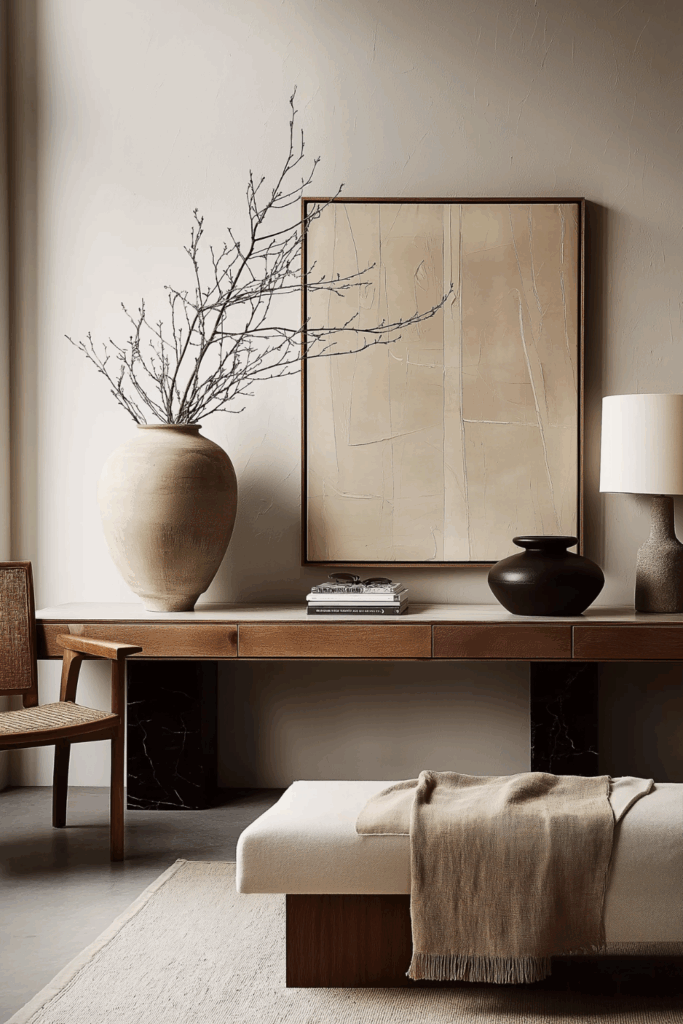
If you’ve fallen in love with the soul-soothing serenity of Organic Modern design, then Japandi might feel like a natural extension of your style story. At their core, both aesthetics are rooted in similar values: a reverence for nature, an appreciation for honest materials, and a belief that our homes should nourish our wellbeing, not overwhelm it.
Japandi interiors speak the same quiet language as Organic Modern spaces. Both are grounded in tactile textures like wood, linen, and stone, and celebrate craftsmanship over consumerism. They invite us to slow down and surround ourselves with objects that hold meaning: a hand-thrown ceramic cup, a perfectly imperfect bench, a branch placed just so.
Where Organic Modern embraces soft forms and layered earth tones, Japandi brings structure through clean lines and thoughtful contrast. Together, they create an elevated sense of calm, minimalist but never cold, refined but still deeply human. This pairing feels especially relevant today, as more of us seek to simplify our spaces and reconnect with what really matters.
Soulful minimalism isn’t just a trend, it’s a shift. A gentle movement toward sustainability, intentionality, and a slower, more grounded way of living. Japandi and Organic Modern are both reflections of that mindset… and when blended thoughtfully, they form a design language that’s both timeless and healing.
Simplicity That Speaks
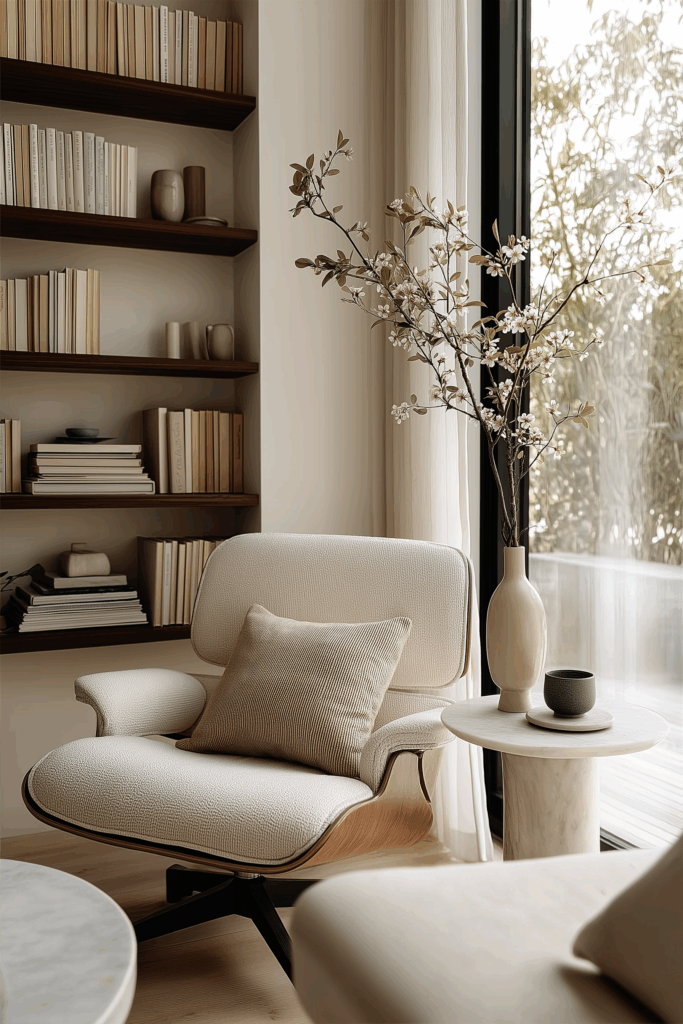
Japandi interior design reminds us that less isn’t just more; it’s more meaningful. Rooted in the gentle balance between Scandinavian simplicity and Japanese wabi-sabi, this aesthetic brings a grounded, soulful energy into our homes. Every element, from the grain of natural wood to the soft crumple of linen, whispers calm… intention… grace.
In a world that often feels noisy and rushed, Japandi offers a quiet retreat, a space to breathe, reflect, and just be. Whether you’re drawn to the earthy textures, the uncluttered layouts, or the way light softly dances across raw materials, this style invites you to create beauty with purpose.
Start small. Clear one surface. Choose one piece that truly speaks to you. Let your space evolve slowly, like nature itself, one thoughtful layer at a time.
✨ Ready to bring Japandi’s timeless calm into your home?
Explore more Japandi inspiration on the blog and follow along on Pinterest for daily doses of serene design.
